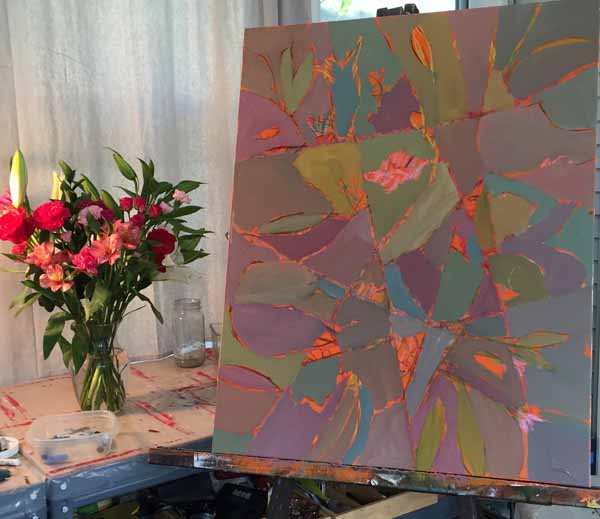
Testing acrylic paints with pastels
30×24 inches
©2016 Lucinda Howe
In the on-line workshop I recently completed, the goal was to loosen up by painting with big brushes on large canvases. We used latex flat house paint samples from Lowe’s or Home Depot along with charcoal, soft pastels, and graphite. We built the painting with layers of drawing and muted colors before adding brighter colors and more detail in the final layer.
Although there was considerable expense in buying a broad selection of paint samples, it was less than buying artist quality paints to cover the same expanse of canvas. And the instructor said that using the house paint made it seem less “precious” and easier to use the amount of paint needed to get the desired effect.
I really liked the results of this process, but I had some concerns about the durability of house paint. Would it fade or crack? Other artists cautioned me that collectors would not appreciate it. House paint is formulated to last about 10 years; it isn’t designed to be archival like artist quality paints. I know that museums have experienced problems with the durability of works by 20th century artists who used house paint such as Picasso, Pollock, Kline, and Hofmann. My Google research tells me that if I want my work to last and to be considered good quality by collectors, it’s better to use artist paints.
So I have challenged myself to get similar results with the acrylic paints that I normally use. Since these paints are quite intense and glossy, my challenge is to mute the intensity and give a flat texture to the early layers so that I will have some tooth for the charcoal and pastel drawings. For the piece I’m working on this week, I started with my usual Holbein orange gesso and then added my drawings. For the “grayish” layer, I combined some odd colors of Golden fluid acrylics with white gesso to get a flat texture. I even found a use for Burnt Sienna. Apparently if you want muddy colors on purpose, it has a place. I used a 1-inch brush and kept mixing on the palette to make a slightly different color for each section, and was pretty happy with the results.
I have more work to do on this piece, but so far, I’m happy to be achieving the loose style with the artist paints. But I would not have known how to do this technique without working with the house paints, so I think the workshop was a valuable exercise.
What do you think about using house paints for art? Do you use them in your artwork? Do you care how long your work lasts? How much difference in price (if any) would you expect for a piece created with house paints versus artist quality paints?

Norman Haslop
12 Apr 2016Personally, I don’t think much about the longevity of a particular piece while I am painting it. Experimentation is my method of learning. Many of my experiments have resulted in having learned not to do that particular thing in that particular way, but sometimes a surprising thing happens and it is a joyful experience.
As for what happens later, and where the painting goes, I may give a caution to the buyer or person who gets my work if I think there is a reason. Handling often has the most to do with longevity – at least in our lifetime. We only have the word of others as to the effects of very long periods of time and no guarantee that our work will always be handled carefully.
For me, the price is always a subjective matter and hardly ever a cut-in-stone value.
lucindahowe
13 Apr 2016You make a good point, Norman. Careful handling and good environmental conditions are crucial to longevity of artwork.